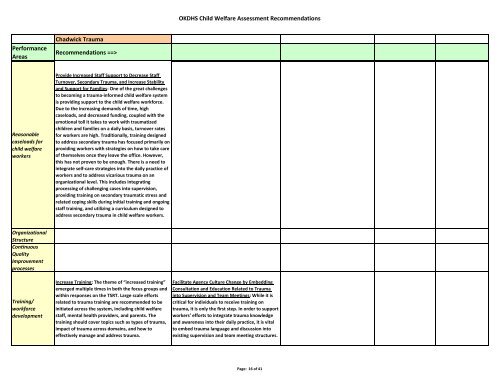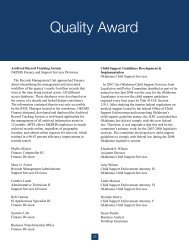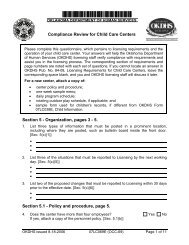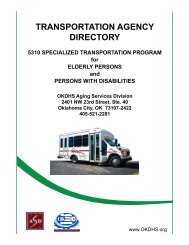Okdhs Child Welfare Assessment Recommendations - Oklahoma ...
Okdhs Child Welfare Assessment Recommendations - Oklahoma ...
Okdhs Child Welfare Assessment Recommendations - Oklahoma ...
You also want an ePaper? Increase the reach of your titles
YUMPU automatically turns print PDFs into web optimized ePapers that Google loves.
OKDHS <strong>Child</strong> <strong>Welfare</strong> <strong>Assessment</strong> <strong>Recommendations</strong><br />
Performance<br />
Areas<br />
Chadwick Trauma<br />
<strong>Recommendations</strong> ==><br />
Reasonable<br />
caseloads for<br />
child welfare<br />
workers<br />
Provide Increased Staff Support to Decrease Staff<br />
Turnover, Secondary Trauma, and Increase Stability<br />
and Support for Families: One of the great challenges<br />
to becoming a trauma-informed child welfare system<br />
is providing support to the child welfare workforce.<br />
Due to the increasing demands of time, high<br />
caseloads, and decreased funding, coupled with the<br />
emotional toll it takes to work with traumatized<br />
children and families on a daily basis, turnover rates<br />
for workers are high. Traditionally, training designed<br />
to address secondary trauma has focused primarily on<br />
providing workers with strategies on how to take care<br />
of themselves once they leave the office. However,<br />
this has not proven to be enough. There is a need to<br />
integrate self-care strategies into the daily practice of<br />
workers and to address vicarious trauma on an<br />
organizational level. This includes integrating<br />
processing of challenging cases into supervision,<br />
providing training on secondary traumatic stress and<br />
related coping skills during initial training and ongoing<br />
staff training, and utilizing a curriculum designed to<br />
address secondary trauma in child welfare workers.<br />
Organizational<br />
Structure<br />
Continuous<br />
Quality<br />
Improvement<br />
processes<br />
Training/<br />
workforce<br />
development<br />
Increase Training: The theme of “increased training”<br />
emerged multiple times in both the focus groups and<br />
within responses on the TSRT. Large scale efforts<br />
related to trauma training are recommended to be<br />
initiated across the system, including child welfare<br />
staff, mental health providers, and parents. The<br />
training should cover topics such as types of trauma,<br />
impact of trauma across domains, and how to<br />
effectively manage and address trauma.<br />
Facilitate Agency Culture Change by Embedding<br />
Consultation and Education Related to Trauma<br />
into Supervision and Team Meetings: While it is<br />
critical for individuals to receive training on<br />
trauma, it is only the first step. In order to support<br />
workers’ efforts to integrate trauma knowledge<br />
and awareness into their daily practice, it is vital<br />
to embed trauma language and discussion into<br />
existing supervision and team meeting structures.<br />
Page: 16 of 41
















